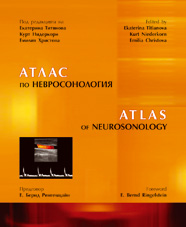Edited by
Assoc. Prof. Ekaterina Titianova, M.D., Ph.D., D.Sc.
Prof. Kurt Niederkorn, M.D.
Assoc. Prof. Emilia Christova, M.D., Ph.D.
 Neurosonology has become a worldwide appreciated clinical and scientific tool box devoted to the use of ultrasound techniques for the detection and investigation of the cerebrovascular system in health and disease. In addition, it has recently also been detected to be useful in analysing the soft tissue of the brain stem and the basal ganglia in movement disorders and dementias. The attractiveness of this spectrum of ultrasound applications is particularly triggered by their absolute non-invasiveness, their availability in most modern hospitals, the rapidity of a precise diagnosis, the closeness of ultrasound techniques to clinical practise, the complexity of the tools in the hands of experienced physicians and technicians and by the uniqueness of the information received not provided by other neuromedical techniques including MRI.
Neurosonology has become a worldwide appreciated clinical and scientific tool box devoted to the use of ultrasound techniques for the detection and investigation of the cerebrovascular system in health and disease. In addition, it has recently also been detected to be useful in analysing the soft tissue of the brain stem and the basal ganglia in movement disorders and dementias. The attractiveness of this spectrum of ultrasound applications is particularly triggered by their absolute non-invasiveness, their availability in most modern hospitals, the rapidity of a precise diagnosis, the closeness of ultrasound techniques to clinical practise, the complexity of the tools in the hands of experienced physicians and technicians and by the uniqueness of the information received not provided by other neuromedical techniques including MRI.
Neurosonology is also about to take the next major step to a promising future, i.e. therapeutic ultrasound. Various ultrasound applications have turned out to enhance the lysis of occluding thrombi in the brain arteries by means of a chemico-mechanical interaction (sonothrombolysis; sonothrombotripsia) although potential side effects (predominantly bleedings) are not yet under control.
As demonstrated in this excellent atlas and text book, the scope of neurosonology in the vascular system encompasses the study of asymptomatic, as well as symptomatic patients, in both primary prevention, acute stroke emergency, secondary prevention and post-stroke care. Neurosonology has gained a major importance in clinical practise, particularly in Europe where this tool traditionally is mostly in the hands of neurologists, neurosurgeons, vascular surgeons and angiologists, but is also routinely used in research laboratories by various neuroscientists, e.g. for research in neurocognition or in systemic circulation - brain interactions.
This atlas represents the state of the art knowledge in the most modern and most informative vascular ultrasound technique presently used, i.e. the colour coded duplex sonography (CCDS). This bilingual issue is written in English in order to become a comprehensive source of neurosonological information for clinicians and researchers of the international scientific community. It is also written in Bulgarian to provide these colleagues a rapid access to the rich body of pathophysiological, clinical and specific neurosonological information. A switch between English and Bulgarian language is always possible and invites the international reader to share and enjoy reading and studying with his/her Bulgarian colleagues and friends.
At a time when cost-effectiveness in medicine is guiding (nearly) everything, neurovascular ultrasound provides a cost-effective alternative to CT-angiography or MR-angiography for the imaging of the cerebral vasculature without, however, playing only the role of a cheap, second-choice replacement for more expensive tools. There are several aspects where ultrasound clearly is ahead of any other neuroimaging techniques. These are microembolus detection, direct visualisation of the moving vessel wall, floating thrombi or the flowing blood, measuring changes in blood flow velocities over time with an otherwise unachieved temporal resolution, continuous monitoring of blood flow velocities over hours if desired, functional transcranial doppler sonography to investigate neurovascular coupling during cognitive performance and, quite recently, brain tissue perfusion imaging at the bedside in peracute stroke patients. Mobility and flexibility are major advantages of ultrasound bringing the imaging study to the patient, and not vice versa. This holds true for the emergency room, the stroke unit or the intensive care facility. Equally useful is the ability to investigate the status of the vascular tree in an ambulatory setting, or to repeat the investigations with reasonable costs as often as desired for follw-up. Thus, neurovascular ultrasound is a key technique to provide the best possible care to neurological patients.
Prevention of stroke is an extremely important requirement for modern societies, and modalities fighting the threat of stroke and its underlying cerebrovascular diseases. Ultrasound-based prevention will play an increasing role in the practise of neurological services worldwide.
The authors of this book are well recognised as leading researchers and clinicians in the field of stroke and neurovascular ultrasound. I had the pleasure of witnessing their excellent work and scientific contributions over the past decades.
I am sure that this book will truly fill a void in the Bulgarian, but also in the international literature on neurosonology and will provide a practical source of information for everyone interested or already involved in this field. I would particularly recommend this atlas to those colleagues just embarking on this exiting journey. Its content clearly proves that the field of neurosonology enjoys both a dynamic present and a bright future.
E. Bernd Ringelstein, M.D., F.A.H.A., F.E.S.C.
Vice President of the European Society of Neurosonology and Cerebral Hemodynamics, Professor and Chairman of Neurology, Department of Neurology University Hospital Munster, Germany


